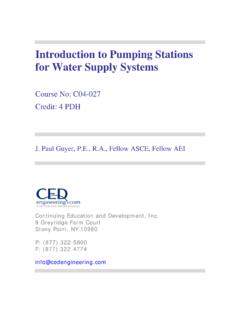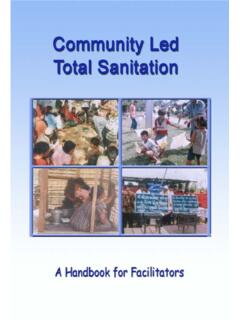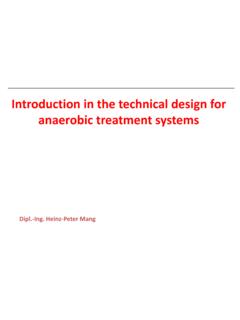Transcription of Metcalf Eddy, Inc. Wastewater Engineering - SSWM
1 Metcalf & Eddy, Inc. Wastewater Engineering Treatment and Reuse (Fourth Edition). George Tchobanoglous Franklin L. Burton H. David Stensel Wastewater Engineering : An Overview 1-1 TERMINOL(X;Y 3. 1 2 IMPAO OF REGUlATIONS ON Wastewater ENGINtERING 3. 1-3 HEALTH AND ENVIRONMENTAl CONCERNS IN Wastewater . MANAGEMENT 7. 1-4 Wastewater CHARAOERISTICS 9. Improved Analyt1cal Techniques 10. Importance oF Improved vVastewater Characterization 10. 1-5 Wastewater TREATMENT 10. Treatment Mefhods I I. Current Status 12. New Directions ond Concerns 15. Future Trends in Wastewot Treatment 20. 1 6 Wastewater RECLAMATION AND REUSE 20. Current Status 21. New Directions and Concerns 2 1. Future Trends in Technology 21. 1-7 BIOSOLIDS AND RESIDUALS MANAGEMENT 22. Current Status 22. New Directions and Concerns 23. Future Trends in Biosolids Processing 23. REFERENCES 24. Every community produce" both liyuid and solid wastes and air emissions.)
2 The liquid wastr- Wastewater --i~ e~scntially the water supply of the community after it has been used in a variety ()f applic<Uiuns (see Fig. 1-1 ). From the standpoint of sources of gener~. ation, Wastewater may he de fined a~ a combmation of the liquid or water-carried wastes removed from residence-;. imtimtinns, ;md commercial and industrial establishmentc;, together with such groundwater. ~urface water. and stonnwater as may be present. When untreated wastt' ater aa:curnulates and is allowed to go septic. the decom- position of tbe organic rnaucr il contain~ will lead to nuisaoce conditions including the production of malodorou" ga!'.es. In addition, untreated Wastewater contains numerous , 2 I Chapter 1 Wasl'ewoter Engineering : An Overview Figure 1-1. Schematic diogrom of a waslewoter monogeme11t infrastructure. Domeslie ~ Wastewater cso treatment facility OWF.
3 /rreatment facility pathogenic microorgan i~ms that dwell in the human intestinal tract. Wastewater also contains nutrient~, which can ~timulate the growth of aquatic plants, and may contain toxic compound!! or compounds that potentially may be mutagenic or carcinogenic. For these reasons, the immediate and nuisance-free removal of Wastewater from its sources of generation, followed by treatment, reuse, or dispersal into the environment is neces- sary to protect public health and the environment. Wastewater Engineering is that bmnch of environmental Engineering in which the basic principles of science and Engineering are applied to solving the issues associated with the treatment and reuse of Wastewater . The ultimate goal of Wastewater Engineering is the protection of publi<.: health in a manner commensurate with environm ental, eco- nomic, social, and political concerns.
4 To protect public health and tbe environmem, it is necessary to have knowledge uf (I) constituents of concern in Wastewater , (2) impacts of these constituent~ when Wastewater is dispersed into the environment. (3) the transfor- mation and 1ong-term fate of these constituents in treatment processes, (4) treatment 1-2 Impact of Regulations on Wa~tewoter Engineering J 3. methods that can be used to remove or modify the constituents found in Wastewater , and (5) methods for beneficial usc or disposal of solids generated by lhe treatment systems. !o provi?e an initi~l persp~ctive on the field of wa~:~tewater Engineering , common tenmnology lS first detmed followed by (I ) a discussion of the issues that need to be addressed in the planning and de!.ign of Wastewater management systems and (2) the current status and new directions in wa~tewater Engineering . 1-1 TERMINOLOGY.
5 Ln the literature. and in governmental regulanons, a variety of terms have been used for individual constituents of concern in Wastewater . The tenninology userl commonly for key concepts Ulld tenns in the field of Wastewater management is summarized in Table 1- 1. In some cases. confusion and undue negative perceptions arise with the use of the terms contdminants. impuriries, and pollutants, which are often used interchangeably. To avoid confusion. the term cotlstiruent is used in thi~ text in place of these terms to refer to an individual compound or clement, such as ammonia nitrogen. The term ;tic is used to refer to a group of constituents, such a) physical or biological chamcteristic~. The tenn <~sludge" has been u11ed for many years to signify the residuals produced in Wastewater treatment. (n 19<>4, the Water Environment adopted a policy defining " as a prim;uily organic, solid Wastewater treatment product that can be recycled beneficially.
6 Tn th is policy, "solids'' are defined as the residuals thar are derived from the treatment of Wastewater . Solid~ that have been treated to the poim at which they are suimble for ben~ficia1 use are termed ''biosolids." In this text, the tenns of solids and biosolids are used exten"iively, but "sludge" continues to be used. espe- cially in cases where untreated solid material and chemical residuals are referenced. 1-2 IMPACT OF REGULATIONS ON. Wastewater Engineering . From about 1900 to the early 1970s, treatment objectives were concerned primarily with (I) the removal of colloidal, suspended, and floatable material, (2) the treatment of biodegradable organic!\, and (3) the elimination of pathogenic organismo;. Imple- mentation in the United State!. of the Federal Water Pollution Control Act Amendments of 1972 (Public Law 92-500). also known as the Clean Water Act (CWA), stimulated substantial changes in wascew11ter treatment to achieve the o~jectives of "fishable and swimmable" Unfortunately.
7 These objectives were not uniformly met. From the early 1970s to about 1980, wa~tewater treatment objectives were based primarily on aesthetic and environmental concerns. The earlier objectives involving the reduction of biological oxygen demand (BOD), total suspended solids (TSS). and path- ogenic organisms continued but at higher levels. Removal of nufriencs, such as nitrogen and phosphorus, also began lt) be addre~sed, particularly in some of the inland streams and lakes, and estuaries and hays such a<: Chesapeake Bay and Long Lc;land Sound. Major programs were :n h)' both Mate and federal agencies to achieve more effective and widespread treatment of Wastewater to improve the quality of the surface waters. These programs were b(lbC::d, in part, on (I) an increased understanding of the environmental effects caused by Wastewater discharges; (2) a greater appreciation of the adverse Jong-tenn effects caused by Lhe (.
8 Li:-;charge of some of the specific constituents 4 I Chapter I Wastewater Engineering : An Overview I. Table 1-1. Terminology commonly used in the field of Wastewater engineering0. Tenn Definition Biosolids P~ an organic: semisolid wast~~'Oter ptoduct that remains ofter solids ore stabilized or chem colly ond ere su toble for bene~cial use Cla~s A biosolid~h B1osolids in which t~e pathogen~ (induding entefic virv~~, pathogenic bacteria, ond viable helminth ova) ore reduced below current detectable levels Closs B bio)()lids11 Biosolids in which the pathogens are reduced to levels that are unlikely to pore o threat to public health and the environment under specific use conditions. Closs 8 biosolids cannot be sold or given away in bags or oth~ container$ or applied on lawns or home gardens Chorocteri$tic!. General classes of Wastewater constituents such os physical, chemical, biological, ( Wastewater ) and biochemical Composition The makeup o{ wa5tewater, including the physical, chemical, and biological constituents Constituentsc Individual component~, elements, or biological ~ntities such as suspended solids or ammonia nitrogen Contaminants Constituents added to the water supply through use Disinfection Reduction of disease-causing microorganisms by phys;col or chemical means EfRuent The liquid discharged from o processing step Impurities Constituenis added to the water supply through use Nonpoint source~ Sources of pollution thot originate from multiple sources over o relatively large areo Nutrient An element that is essential for the growth of plants and animals.}
9 Nutrients in Wastewater , usually nitrogen and phosphorus, may cause unwanted algol and plant growths in lakes and streams Po,.orne~r A meosuroble foetor such os temperature Point sources Pollvtional loads discharged at o speci~c kx:ohon from pi~$1 ot,~tfolls, and conveyance methods from either municipal Wastewater treatment plants or industrial WO$te treatment facilities Pollutants Consti!uenls added to the wote supply through t.~se Reclamation Treatment of waslewoter for subsequent reuse application or the od of reusing treated Wastewater Rccyding T~e reuse of treated wmtewater and biosolids for bene~cial purposes Repurificotion Treatment of Wastewater to a level suitable for a variety of appl~cafions includ~ng indirect or direct potable reuse Revse Beneficial use of reclaimed or repurified Wastewater or stabaized biosolids Sludge Solids removed from Wastewater during treo~nt.
10 Solids 1hot are treated Further ore termed biosolids Solids Material removed from wmtewater by 9ravity sepora~on !by darifiers, thickeners, and lagoons) and ;s the solid residue from dewatering operations 0. Adopted, in port, from Crites ond Tchobonoglous 11 998]. b EPA {1997b). ' To avoid confusion, the term ''consf1tuents" is used in th 1 ~ tcx 1n place of c;ontommants, impurities, and pollutants . 1- 2 Impact of Reguloti011s on Wastewater Engineering I 5. t"ound in Wastewater : and (.~ l th~ devdoprnent of national concern for the protection of the environment. As a re~ult of these programs. significant improvements have been made in the quality of the 'iurfa~.:~ water~ . Since 1980, the water-quality improvement objectives of the 1970s have continued, but the emphasis ; shift~d to th~ dt:tinition and removal of constituents th:1t may cause long-term health effcl't~ and em impact\.}











